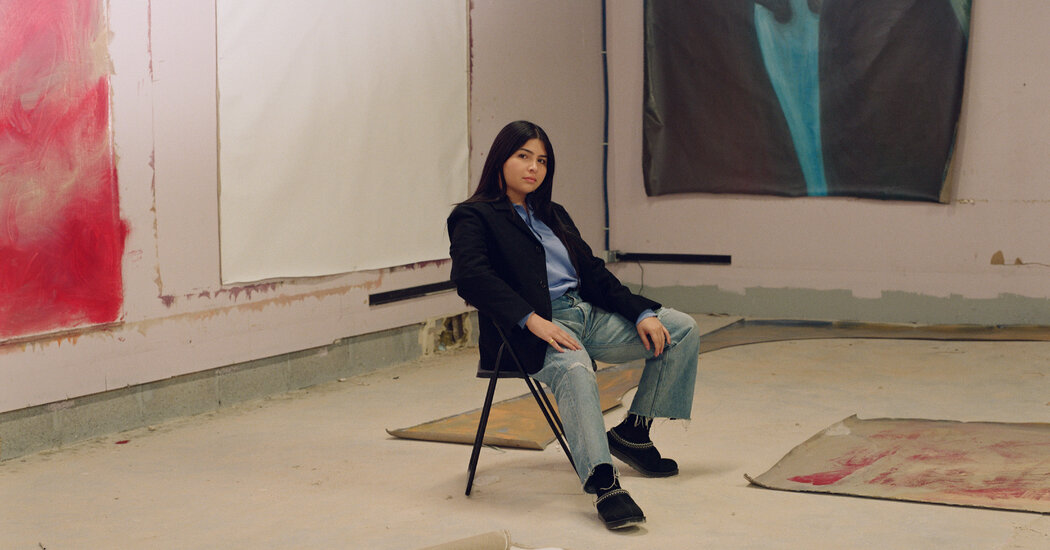
PARIS — Compared with the junk she’s found in other cities, “Parisian trash is sturdy,” Ser Serpas said. She speaks from experience — at 27, the itinerant artist and poet is admired in European and North American art circles for precariously poised arrangements of urban discards found near the venues where they’re shown. They become site-specific descriptions of a place, written in its own delaminating school desks and tarnished bathtubs.
Serpas belongs to a loose cohort of millennial artists and poets, including Hannah Black, Precious Okoyomon and Rindon Johnson, rethinking found materials through deceptively deadpan sculptures. Like many of her peers, she favors objects that bear the marks of use, as if, having inherited a sorely used world, she’s making stanzas from its leftovers.
One blustery afternoon last November, I trailed Serpas and Rafik Greiss, her collaborator and gallery-mate at Balice Hertling there, as they hunted for inspiration in the 19th Arrondissement. Serpas was in Paris for a residency, relatively fresh from Tbilisi, Georgia; and Geneva before that.
“People tape things up here,” she said. “It makes it into a new object. Like these poles.” Right on cue, the city provided four metal rods loosely bundled with duct tape. Serpas moved in. She wove the rods through a wooden shipping pallet, and wedged up the contraption with a broken oscillating fan. Then she struck a pose herself, long hair wafting, electric-blue workwear and Day-Glo gloves popping against the wispy sky, while Greiss crouched and snapped his camera like a fashion hound.
Serpas usually works alone, and indoors, but this series is different. More narrative, she says, and more about her. The photos she and Greiss made are destined for her exhibition Jan. 25 through April 23, at the Swiss Institute in Manhattan, her largest institutional solo effort to date. The photos offer a peek at her process. The sculptures they depict lasted only minutes.
A culture’s refuse says a lot. The trash in Switzerland, where Serpas earned her M.F. A., is scarcer and better maintained. You need to know the garbage routes. In New York, the trash is plentiful, unruly, almost a point of pride. The sculptures are also self-portraits, reflecting the artist’s sensibility and spirit. In Paris, we came across a polite lineup of broken-up furniture against a hunter green fence. Serpas slotted the top of a captain’s table into a mirrored medicine cabinet. “Oh,” she said, “this makes a good tongue.”
Serpas grew up in the Boyle Heights neighborhood of Los Angeles. She shared a bedroom with her mother until she was 16. Her mother works for the Los Angeles Police Department; at onetime she processed property seizures, at another she registered sex offenders.
In early interviews, Serpas often mentioned her teenage activism. “I don’t believe in art as activism, like, at all,” she told me. She moved to Morningside Heights in 2013 to pursue urban studies at Columbia. In New York, though, classmates who’d attended elite private schools in New England talked down to her about gentrification in Los Angeles. She drifted away from the dissonance of collegiate politics and toward the blurry, permissive worlds of art, fashion and nightlife.
A fine-art concentration afforded Serpas a luxury she’d never had: four walls of her own. She dived into drawing, angsty verse and grungy assemblages of worn fabric, often passed down from model and designer friends.
Then, in 2017, Quinn Harrelson (son of Sarah Harrelson, founder of “Cultured” magazine) gave Serpas her first solo show at his Miami project space. Harrelson describes Serpas as “an inferno.” She flew down and created dozens of artworks, in a smattering of media, right there in the gallery. But later, walking around the city, they noticed a recently foreclosed house, its guts expelled to the curb. The plan changed. They hired a van and a TaskRabbit, moved the trash into the gallery, and threw the old show away. Serpas stayed up all night in a Red Bull fugue turning the likes of a plate glass tabletop, an upright vacuum, and a thick flaking door into sculptures. “It happened really, really quickly,” Harrelson says, “and extremely lyrically.”
The destroyed materials anchored an aura of decline. The tension and balance of the sculptures echoed the precarity of many lives lived, and fortunes lost, but also their owners’ fragile optimism. As Rindon Johnson wrote in a text for Serpas’s Miami show, “Serpas weaves anti-portraits, that stick to your teeth like afterimages.”
The move to larger objects was a breakthrough for Serpas. Invitations followed to repeat the ritual in cities from Detroit to Berlin.
After seeing a few of Serpas’s sculptures — a mattress kneeling through the hole in a countertop; an Ikea bookshelf sitting in a car seat — their bodily syntax is unavoidable. There’s something anthropomorphic about how the sculptures, fashioned from objects made for human use, limited by what one person can lift and construct without tools or fasteners, hold space. In Paris, I watched Serpas wrestle creamsicle-colored cabinetry into diamond-shaped stacks, but also delicately steady a weathered board on an aluminum rod, over a wavering puddle.
Serpas doesn’t need to invent words; she scans stuff on a curb the way a poet scans language: with an eye for context, kinetics and usage, putting it together like it could all fall apart. She describes her work as “word games.” Her titles are writerly. “This Laptop Has Been Drinking,” in her 2020 show at LC Queisser in Tbilisi, comprises a stained table bearing what’s described as a “wine-soaked laptop,” lid closed, containing “four excised poems.” The Miami show featured a scorched, overturned recliner. Only the lowercased title, “penultimate warrior (self-portrait),” hinted at the piece’s confessional register, and only the list of materials could reveal that it was burned with estradiol, a flammable steroid used in hormone replacement therapy, which Serpas was undergoing at the time.
The word games also determine what her work is, and what it isn’t. When agreeing to far-flung shows, she could be demanding. The work had to be made in situ, in person, by her. “It definitely came out of an angsty place,” she said. “I was like, OK, you have to give me the key and there’s going to be a lot of things in the recycling and I might have some friends over, but you just have to trust me and you’ll get a show. But on my terms.”
At the “Made in L.A. 2020” biennial, that wasn’t possible. To protect the exhibition’s two venues, as well as the other artists’ work, from potential contaminants in her materials, like mold or oils, the curators planned to stage her sculptures outdoors at the Huntington and in a sequestered glass-walled gallery in the Hammer Museum lobby that had already been infested with moths.
Then, there was Covid. Her site-specific work for the biennial could not be realized. Both venues displayed materials their staff had gathered for the artist, unassembled. Serpas contributed text. “These objects constitute the potential for a work or works,” she wrote of the stroller and bumper and grungy traffic cone, among other finds. “These objects will be properly disposed of at the end of ‘Made in Los Angeles 2020.’ ”
The biennial was, if not a breakthrough, then a break. Serpas had grown tired of jet-setting around the artworld to make sculpture, and now that didn’t seem necessary. For the Swiss Institute, Serpas doesn’t feel compelled to show any sculpture at all. The temporary sculptures captured by Greiss’s camera aren’t bespoke portraits of New York City. Instead, they’re pictures of Serpas, in Paris, working where she lives.
But the show will refer to the artist’s formative New York years, too, by way of her college journals, packed with wild poetry and inebriated sketches, arrayed in a series of vitrines. And there will be paintings — the latest from her ongoing series depicting faceless torsos and abstract clefts, bodies alone or cleaving. Some are lovers or would-be lovers, others before-and-after photos of plastic surgery found on the internet. Some are self-portraits. The idea is to fold her sought-after, signature sculpture practice into her larger, explicitly expressive body of work.
Serpas said such a revealing show could only happen at the Swiss Institute, under a curator, Daniel Merritt, whom she’s known since Columbia. Merritt visited her teeming studio during her senior year. “She was hungry for material,” he told me. He remembers one arrangement, a soiled onesie on a chessboard mat splashed with runic handwriting. “We’re in a very unstable time,” he says, “and I think with flair and heart and deep emotion, Ser instigates moments of instability. That process is how you make peace with a world that is constantly being described as crumbling.”
The world of trash is indeed fleeting. As Serpas, Greiss and I wandered through the 19th, we passed a man trying to shove a water heater into a van stuffed with scrap. This way of working puts her in contact with others whose livelihoods depend on the consumption cycle. We paused in front of a sink, bottom out and clogged with hair, still set in its countertop. It didn’t need much. Serpas scooted it in front of a roll-up gate, and posed. We hadn’t walked 10 feet before someone carried it off.




